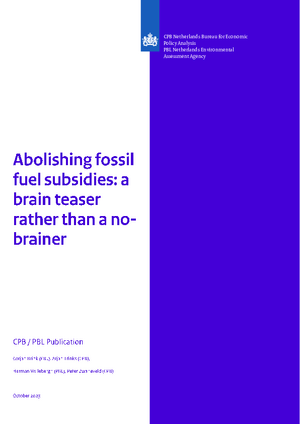Abolishing fossil subsidies useful if it supports the energy transition

Look at climate damages; this requires a different approach
From a climate perspective, it makes sense to focus first on schemes that cause polluters to pay insufficiently for the climate damage they cause. If due to exemptions and reductions the price polluters pay for CO2 emissions is too low, additional pricing is of utmost importance. This is the starting point of an analysis using the ‘external cost approach’. From this perspective, it turns out, for example, that for the Netherlands CO2 emissions are largely sufficiently priced in the built environment, but in many other sectors pricing is insufficient. The external cost approach is helpful in prioritising which regulations to change first.
A pure focus on the level of tax revenue foregone may lead to undesirable policy reforms
Several studies list fossil tax benefits using the ‘inventory approach’ in the Netherlands. In doing so, the level of tax revenue potentially foregone depends heavily on the chosen reference rates (which tax bracket do you compare to?). This is an important explanation for the large differences in the amounts of fossil fuel subsidies reported in several studies. Our study shows that a pure focus on reducing the levels of tax revenue potentially foregone can produce undesirable outcomes. For example, from a climate perspective, it is harmful to sharply increase the lower tax rates for large electricity consumers, as this inhibits electrification, which is a cornerstone of Dutch climate policy.
Both approaches are needed
The inventory approach and the external cost approach both have their merits. Without the inventory approach, it is impossible to see which schemes support fossil fuel use both directly and indirectly. Without the external cost approach, it is impossible to see which changes are most important from a climate perspective.
Bring indirect fossil fuel subsidies into focus
It is important to also look more broadly at schemes that may slow the energy transition by indirectly stimulating fossil energy use. In this study, PBL and CPB have compiled an overview of fossil fuel subsidies using the inventory approach mentioned earlier, which includes many indirect schemes. These indirect schemes are not quantified in this report. Using this overview, the government estimated direct and indirect fossil fuel subsidies in the most recent National Budget and the Budget Memorandum.
Consider fossil fuel subsidies in relation with other policies
When reducing fossil fuel subsidies, it is important to consider the full national and European policy mix. For example, the tightening and expansion of the emissions trading system in the European Union leads to a further substantial reduction in the pricing deficit over time. In addition, abolishing specific schemes can be useful if this ensures a more adequate pricing of climate damages in the shorter term.
Authors


